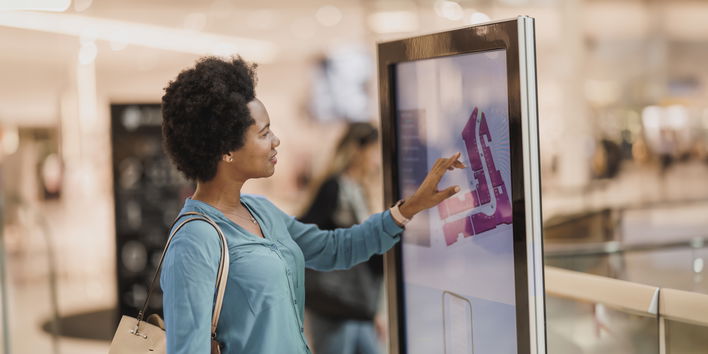Imagine a retail world where every interaction feels personal, every decision is driven by data, and every channel works seamlessly together. Today’s consumers expect more than just products they demand tailored, intuitive, and frictionless experiences. Industry leaders like Amazon’s predictive recommendations and Apple’s omnichannel approach have set the bar, challenging retailers to deliver exceptional customer journeys.
Digital transformation in retail is no longer an option, it’s a necessity for survival and success. By 2025, most retail CEOs will prioritize digital transformation to enhance customer engagement, streamline operations, and future-proof their businesses. Faced with operational inefficiencies, evolving customer expectations, and a growing need for digital skills, retailers must embrace transformation to stay competitive.
Emerging technologies like AI for hyper-personalization, IoT for operational efficiency, and AR for immersive shopping experiences are reshaping the industry. This article explores how digital transformation in retail drives innovation, offering actionable strategies, advanced technologies, and real-world examples to empower businesses to adapt with confidence and thrive in today’s dynamic and demanding landscape.
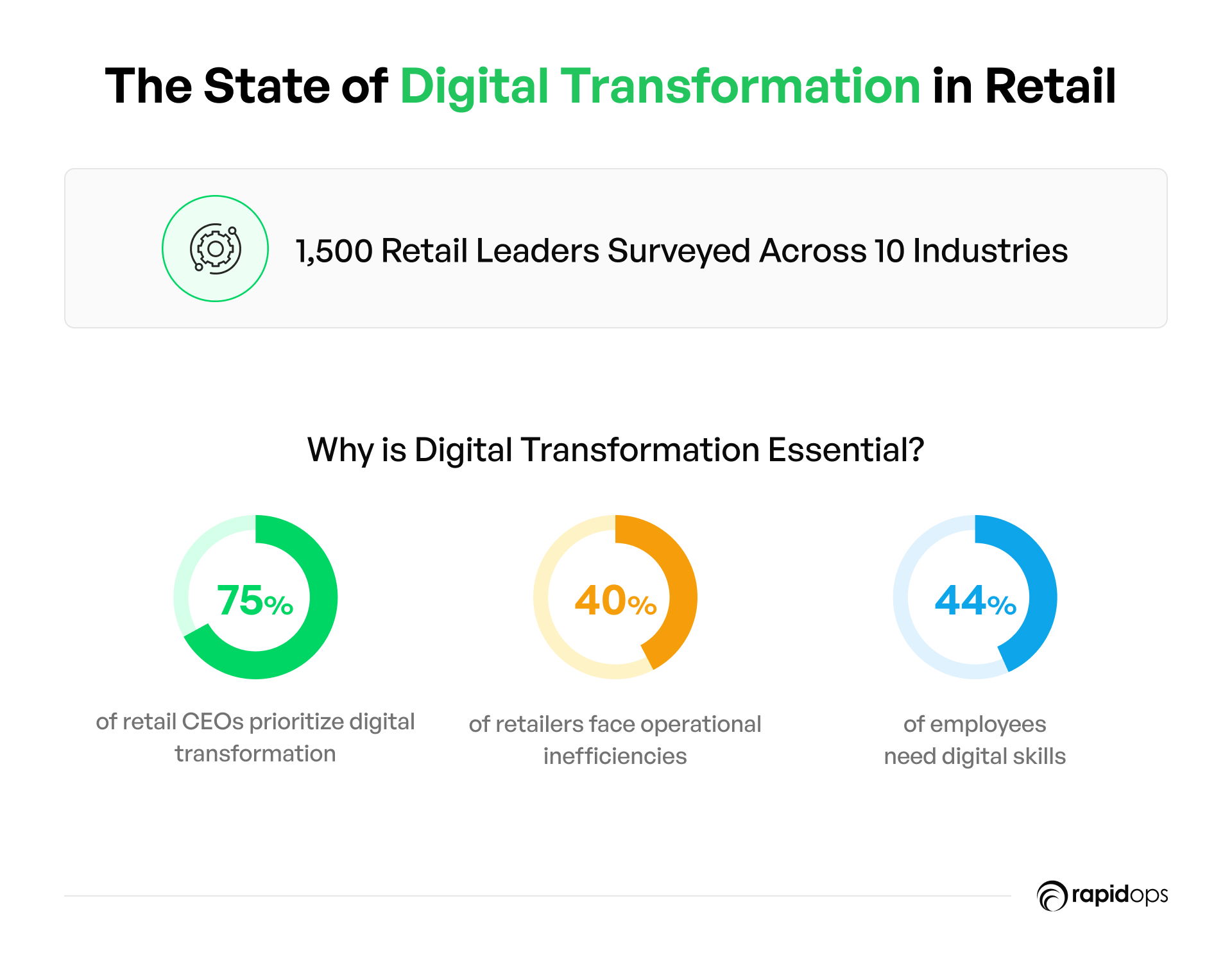
How Digital Transformation is Reshaping Retail
1. Revolutionizing Customer Experiences
As consumers become increasingly digital savvy, they demand more personalized and seamless experiences. Traditional methods no longer meet the need for instant gratification and convenience. Retailers must connect online, in-store, and mobile touchpoints to create cohesive, tailored experiences. This not only meets but exceeds expectations, building loyalty and positioning businesses for success in an increasingly competitive market.
Omnichannel Retail
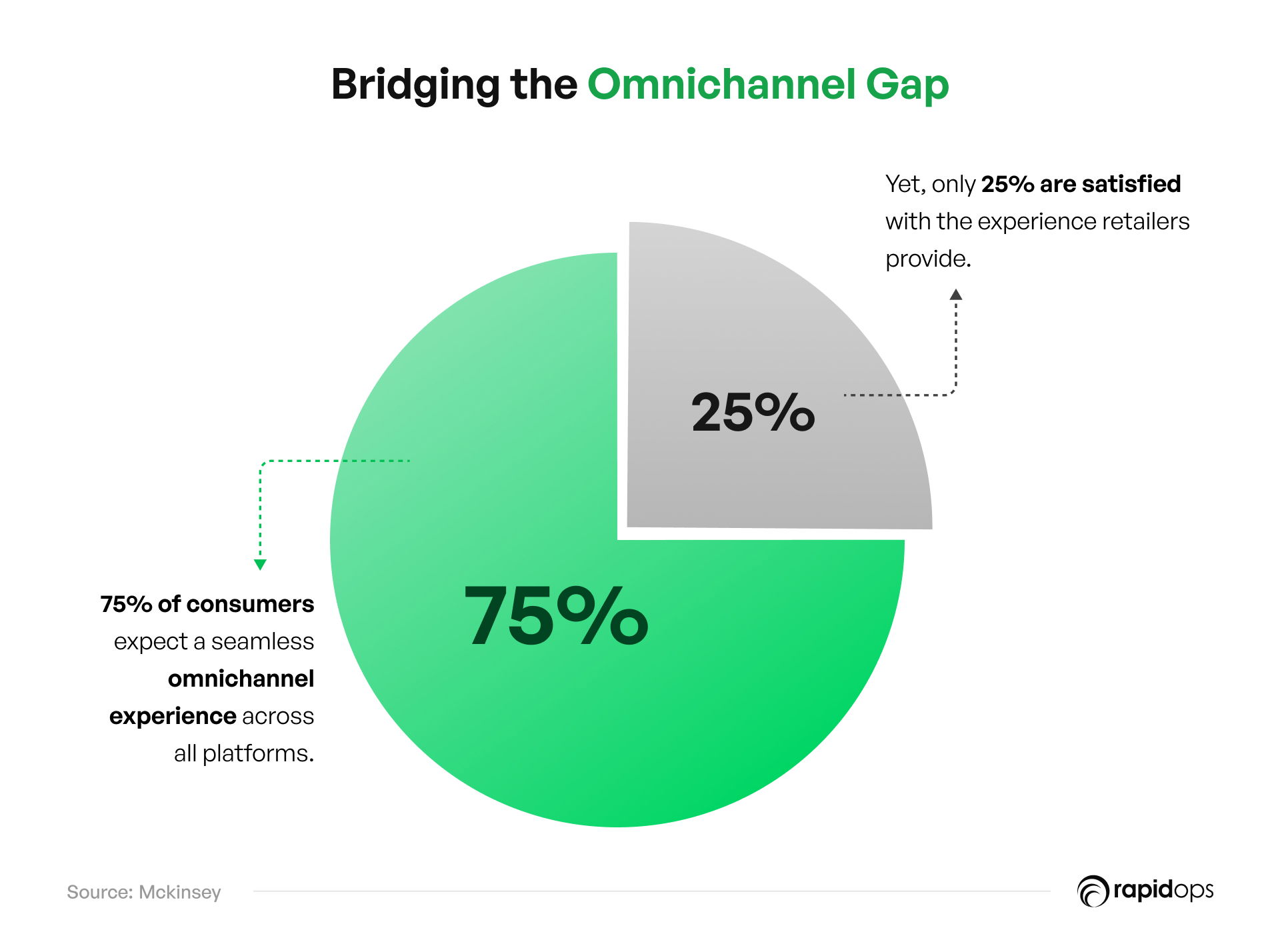
Consumers today demand a seamless experience across all channels, yet many retailers struggle to meet these expectations. The gap between what customers expect and what is delivered highlights the need for digital transformation. By unifying online platforms, physical stores, and mobile applications, retailers can eliminate friction and provide a consistent, integrated ecosystem. This frictionless journey of browsing online, checking in-store availability, and completing purchases via the app not only enhances satisfaction but also builds trust.
AI-Driven Personalization
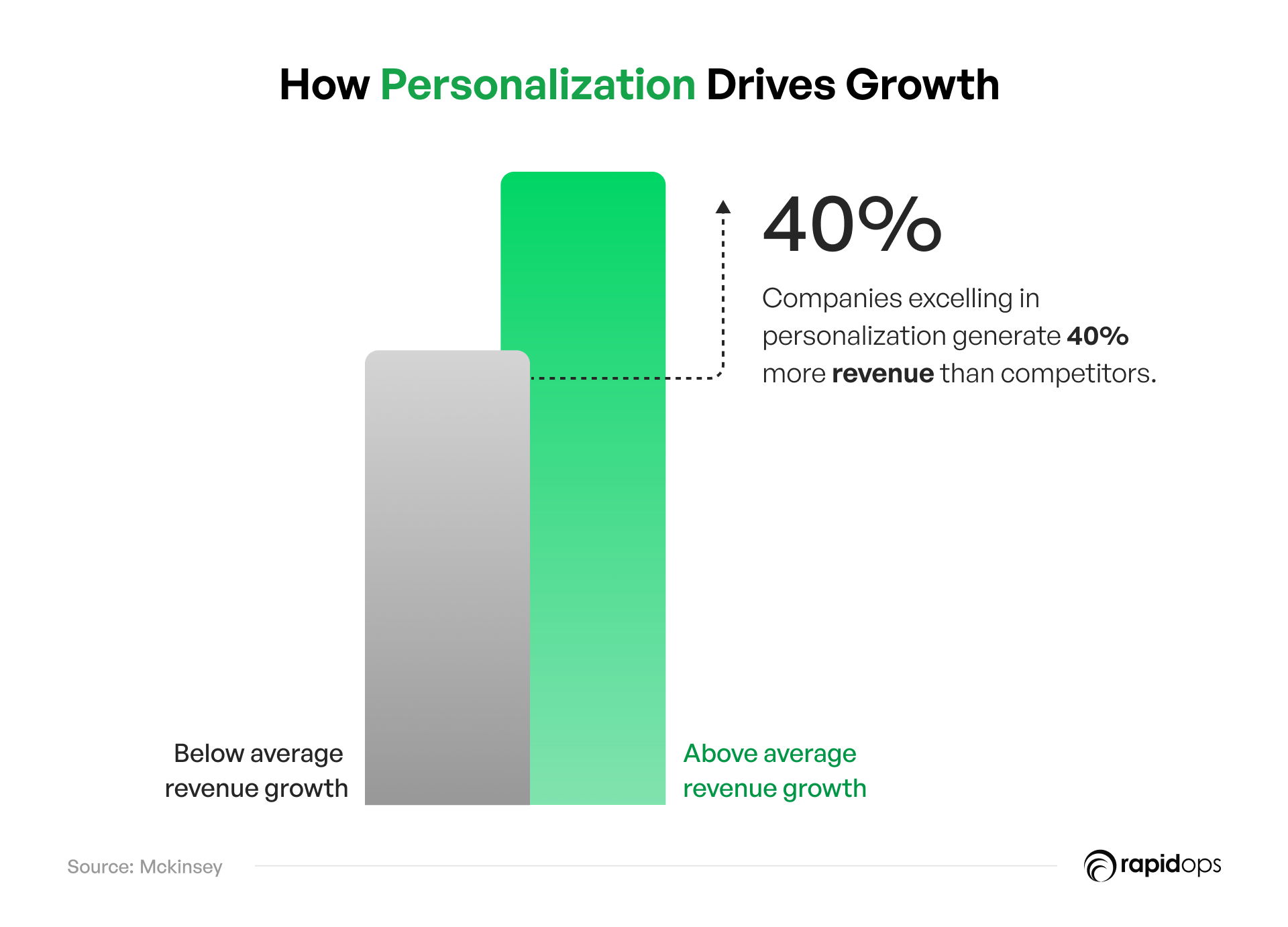
In today’s market, generic marketing no longer captures attention. Consumers want brands to understand their preferences and offer tailored experiences. AI empowers retailers to harness customer data and create hyper-personalized interactions. By analyzing browsing habits, purchase history, and preferences, AI enables tailored product recommendations, dynamic pricing, and relevant promotions. This personalization drives sales and strengthens loyalty, making each customer interaction more meaningful.
2. Redefining Operational Efficiency
Retailers face the constant challenge of balancing cost reduction with rising consumer expectations and supply chain disruptions. In this dynamic environment, embracing digital transformation in retail is crucial to optimizing operations and improving efficiency. By digitizing key processes, retailers can streamline inventory management, staffing, and logistics, fostering the agility needed to quickly adapt to shifting market demands and elevate service levels.
Automation
As operational costs rise and supply chain complexity increases, manual processes often lead to errors, inefficiencies, and delays that negatively impact both the bottom line and customer satisfaction. Automation helps address these challenges by improving supply chain management, inventory control, and order fulfillment. Robotics and automated systems reduce human error, accelerate processes, and ensure faster, more reliable deliveries all while driving cost savings and a better customer experience.
Predictive Analytics
Accurate demand forecasting is essential for maintaining efficient inventory levels and maximizing sales. Predictive analytics powered by AI allow retailers to anticipate demand trends by analyzing historical data and real-time consumer behavior. By aligning inventory with these insights, businesses can reduce waste, avoid stockouts, and meet customer expectations with precision ultimately enhancing operational efficiency and satisfaction.
3. Empowering Decision Making with Data
In today’s rapidly evolving retail landscape, staying competitive requires leaders to make swift, informed decisions. Without accurate data, decision-making becomes uncertain and risky. Leveraging real-time insights through digital transformation in retail empowers businesses to reduce risks, drive growth, and confidently navigate the complexities of a dynamic market.
Real-Time Insights
In an industry where timing is everything, relying on outdated reports or manual processes can result in missed opportunities. Digital tools equipped with real-time analytics offer instant visibility into sales trends, customer behaviors, and inventory levels.
This allows retailers to respond to shifts in demand promptly whether it’s adjusting pricing strategies or restocking inventory, keeping them ahead of market trends, boosting profitability, and enhancing customer satisfaction.
Customer Behavior Analysis
A comprehensive understanding of customer behavior is essential for staying ahead of competitors. With multiple touchpoints, gaining a 360-degree view of the customer can be challenging. Digital transformation bridges this gap by collecting and analyzing data from online interactions, in-store purchases, and social media engagement. These insights allow retailers to personalize marketing efforts, optimize product offerings, and enhance the shopping experience ultimately empowering leaders to make smarter, more impactful decisions.
4. Accelerating Innovation and Agility
Retail operates in a constantly evolving environment where success depends on the ability to adapt to shifting consumer preferences, emerging technologies, and increasing competition. Digital transformation empowers retailers to innovate at speed, whether by launching new products, exploring diverse sales channels, or leveraging advanced technologies. This agility not only enhances customer experiences but also enables businesses to respond swiftly to market changes, ensuring sustainable growth and a competitive edge.
Quick Adaptation to Market Trends
Adapting to dynamic market trends and consumer behavior is essential in retail, especially amid disruptions like economic shifts or supply chain challenges.
Cloud-based platforms and modular technologies provide the flexibility to pivot operations, adjust product offerings, and adopt new services seamlessly. This adaptability ensures businesses stay aligned with customer demands, fostering resilience and competitive strength.
Customer-Driven Innovations
Modern consumers seek personalized and engaging shopping experiences beyond mere transactions. Digital tools allow retailers to experiment with innovations like augmented reality fitting rooms, voice-activated shopping assistants, and tailored virtual shopping experiences. These advancements not only captivate customers but also differentiate brands in a crowded market, driving loyalty and boosting engagement.
This combination of adaptability and innovation positions retailers to thrive in an ever-evolving landscape, meeting customer expectations while staying ahead of industry trends.
How Technology is Transforming the Retail Industry
Technology drives digital transformation by boosting innovation, streamlining processes, and customizing customer interactions. It allows businesses to stay agile, quickly adapt to market changes, fuel growth, and maintain a strong competitive advantage.
Now, let’s explore the key technologies that are transforming the retail industry and how they empower businesses to stay ahead in a rapidly evolving market.
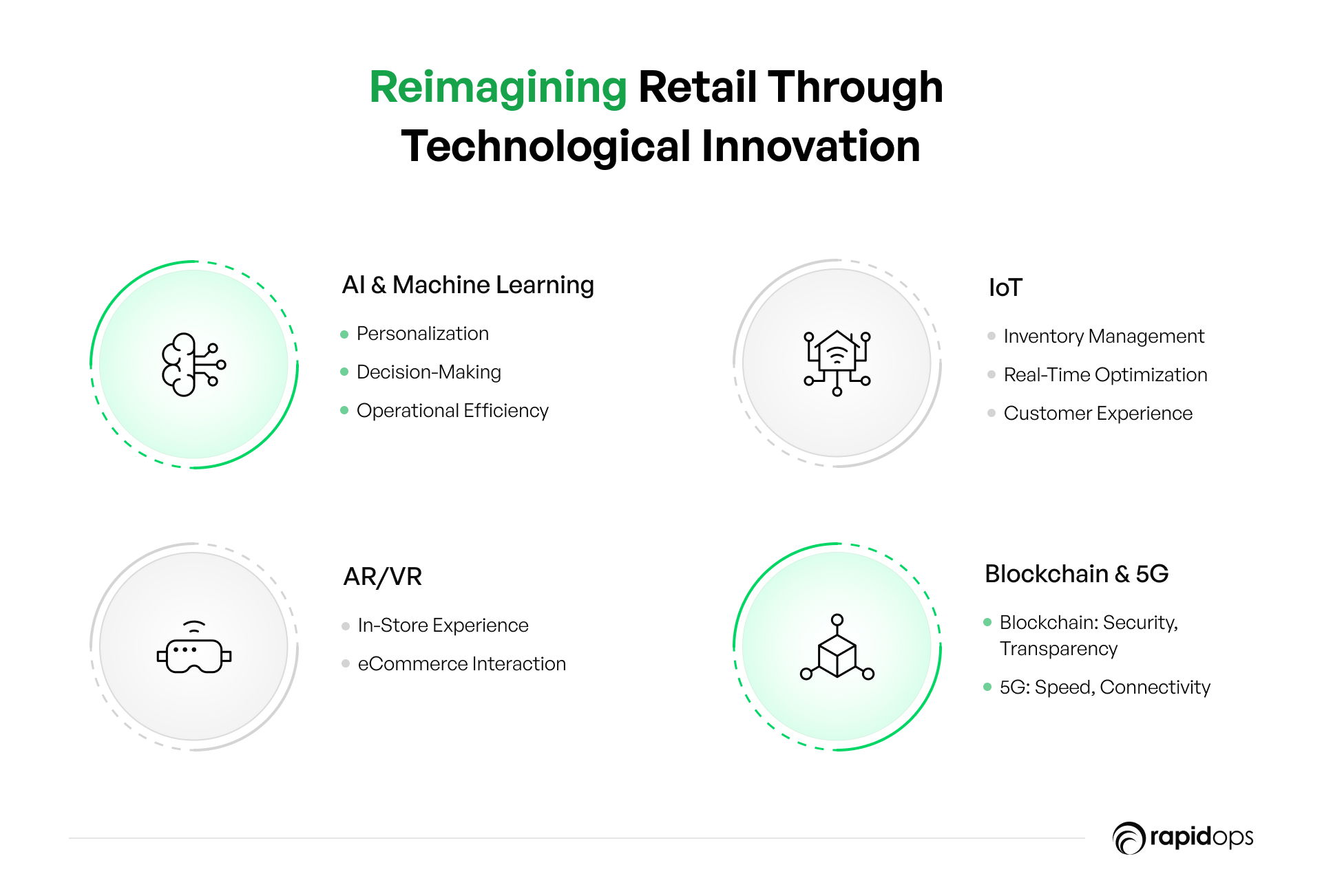
AI and Machine Learning: The Engine of Smarter Retail
AI and machine learning are empowering retailers with the ability to make data-driven decisions, streamline operations, and deliver hyper-personalized customer experiences. By turning vast amounts of data into actionable insights, these technologies are setting a new standard for customer engagement and operational excellence.
- Personalized Experiences: AI uses data from browsing behavior, past purchases, and customer preferences to design individualized shopping experiences. Retailers can deliver tailored recommendations, product suggestions, and personalized promotions that not only boost customer satisfaction but also increase loyalty and drive higher sales conversions.
- Demand Forecasting: AI algorithms analyze historical sales data and trends to accurately predict future demand. This allows retailers to make informed inventory decisions, reducing the risk of overstocking, preventing stockouts, minimizing waste, and ensuring they capitalize on peak demand periods.
- Operational Efficiency: AI streamlines operational workflows by providing real-time monitoring and insights into store and supply chain performance. It enables businesses to identify bottlenecks, optimize staffing, and allocate resources more effectively, ultimately improving overall efficiency and reducing operational costs.
IoT and Smart Devices: Bridging the Digital and Physical Worlds
The Internet of Things (IoT) is revolutionizing the retail landscape by connecting physical stores with digital intelligence, creating seamless ecosystems that benefit both retailers and customers.
- Smart Shelves: Real-time inventory management through IoT-enabled shelves ensures accurate stock levels, reducing stockouts, and improving product availability. This not only enhances operational efficiency but also meets customer demand promptly.
- Automated Checkouts: IoT technology powers automated checkout systems, significantly cutting down wait times and improving transaction speed. This contributes to a smoother, faster, and more satisfying shopping experience.
- Data Driven Optimization: IoT sensors, a cornerstone of digital transformation in retail, collect real-time data, providing actionable insights into customer behavior and store performance. These insights help retailers personalize experiences, optimize operations, and drive sustainable growth while enhancing efficiency and customer satisfaction in a competitive market.
Cloud Computing: Enabling Agility and Innovation
Cloud computing serves as a critical enabler of scalability, flexibility, and operational excellence in modern retail, allowing businesses to innovate and adapt to dynamic market demands efficiently.
- Omnichannel Integration: Cloud solutions unify data and processes across physical stores, e-commerce platforms, and mobile channels, creating a seamless customer experience. This consistency strengthens brand loyalty and reduces friction in customer journeys.
- Scalable Growth: Retailers leverage cloud infrastructure to handle fluctuating demand during peak periods or promotional events, ensuring uninterrupted operations without requiring substantial upfront investments in hardware.
- Enhanced Collaboration: Cloud platforms streamline communication and resource sharing among internal teams, suppliers, and logistics partners, improving decision-making and accelerating time-to-market for new products or services.
AR/VR and the Metaverse: Redefining Customer Engagement
Immersive technologies such as augmented reality (AR) and virtual reality (VR) are revolutionizing the way customers interact with brands, enabling seamless and memorable shopping experiences that foster engagement and simplify decision-making processes.
- Virtual Try-Ons: AR provides customers with the ability to assess products in a personalized context, such as viewing them in their environment or virtually experiencing them. This tailored interaction builds customer confidence by addressing potential concerns, while simultaneously reducing the likelihood of returns and enhancing conversion rates.
- Immersive Storefronts: VR transforms traditional online browsing into a dynamic and interactive experience, giving customers the ability to explore products or services in greater detail. By replicating aspects of physical shopping, this technology bridges the gap between online and in-store experiences, making purchasing decisions more intuitive and less daunting.
- The Metaverse: The metaverse offers a unique opportunity for brands to establish immersive, branded virtual spaces. These environments foster deeper engagement with tech-savvy audiences and create new avenues for building loyalty, innovation, and differentiation in a competitive marketplace.
Blockchain: Driving Trust and Sustainability
Blockchain technology is reshaping the retail industry by enhancing operational transparency, fostering consumer trust, and supporting sustainability-driven practices.
- Authenticity Assurance: Blockchain enables secure, tamper-proof records that trace the entire lifecycle of a product, ensuring that customers receive authentic items. This process builds a foundation of trust, particularly for industries where counterfeiting and quality concerns are prevalent.
- Optimized Supply Chains: By leveraging real-time insights, blockchain improves visibility into supplier performance, inventory levels, and shipment tracking. This leads to streamlined operations, minimized delays, and reduced operational costs, while ensuring that products consistently meet quality standards.
- Sustainability Verification: Blockchain supports ethical and sustainable practices by providing irrefutable proof of sourcing and production processes. Retailers can use this transparency to demonstrate their commitment to eco-friendly initiatives, cultivating trust among ethically conscious consumers.
What Are the Biggest Challenges in Retail Digital Transformation?
The journey toward digital transformation in retail is not without its complexities. It’s a landscape filled with challenges that test strategic thinking, operational resilience, and the ability to adapt to constant change. However, these hurdles are not roadblocks but stepping stones that, when understood and addressed, can pave the way for meaningful transformation.
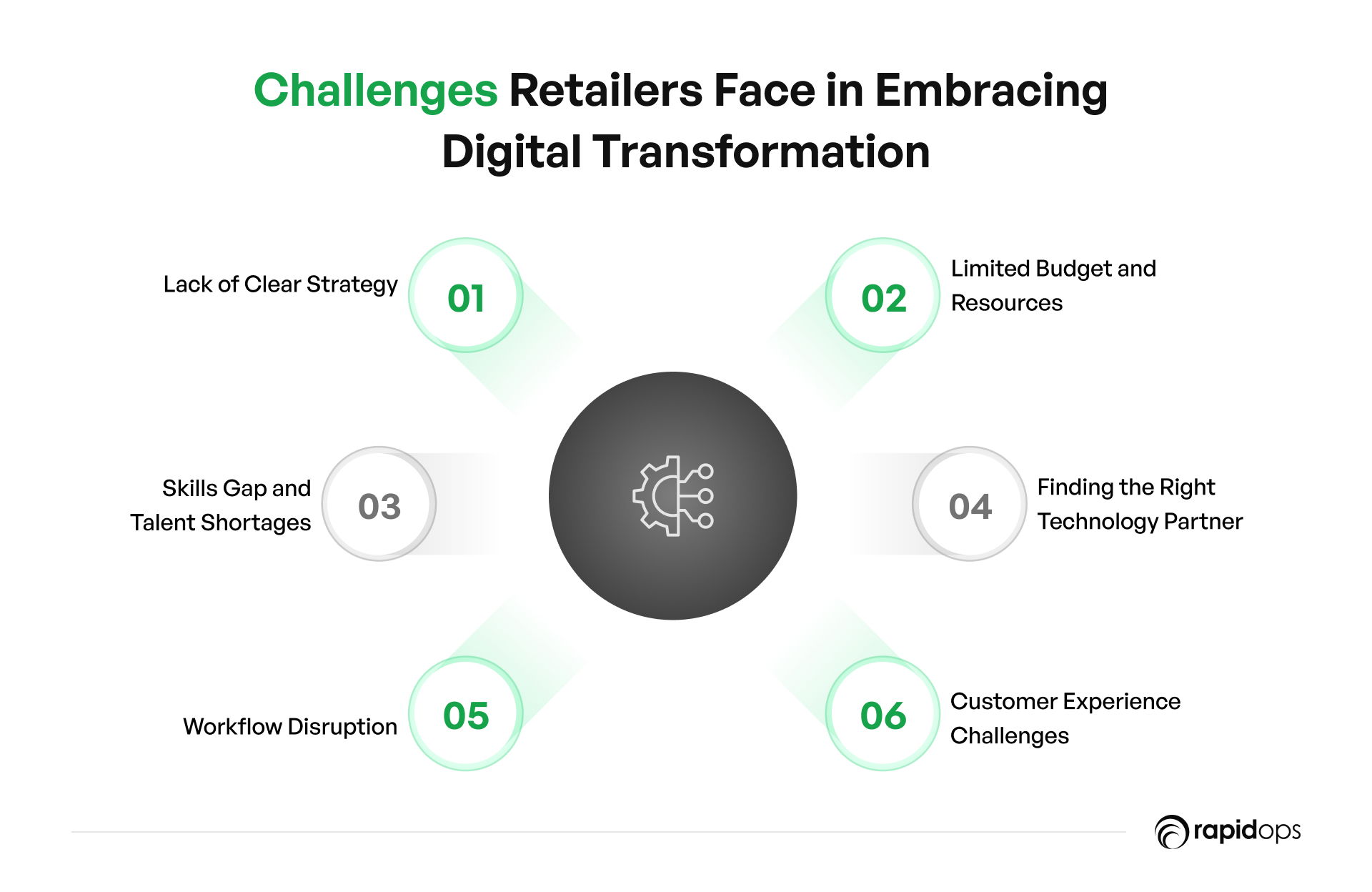
1. Lack of Clear Strategy
Many retailers embark on digital transformation without a well-defined strategy. Without clear goals and a roadmap, transformation efforts can lack direction and fail to deliver measurable results. Retailers often struggle with aligning digital initiatives to their business objectives, which can result in wasted resources and missed opportunities.
Why It’s a Problem
- Missed Opportunities: Without a clear strategy, retailers risk failing to capitalize on growth opportunities, missing key market trends, and underutilizing technology.
- Ineffective Resource Allocation: Efforts can be spread too thin, investing in the wrong areas, leading to resource wastage and slower progress.
- Unclear ROI: The absence of a strategy makes it difficult to measure success, hindering businesses from evaluating return on investment (ROI) and making necessary course corrections.
2. Limited Budget and Resources
Budget constraints and limited resources are a common roadblock in retail digital transformation. With competing priorities, many retailers struggle to allocate sufficient funds for technology adoption, system upgrades, and the talent required to drive transformation.
Why It’s a Problem
- Inability to Scale: Limited resources prevent retailers from scaling technology solutions to meet their growing needs, resulting in inefficiencies and lost potential.
- Technological Gaps: Insufficient budgets may force retailers to settle for suboptimal solutions, which could compromise the customer experience and limit operational effectiveness.
- Delayed Transformation: Without adequate resources, transformation initiatives may take longer to implement, putting the business at a disadvantage compared to more agile competitors.
3. Skills Gap and Talent Shortages
As digital transformation requires advanced skills in areas like data analytics, AI, and cloud computing, there is a significant talent shortage in retail. Many organizations struggle to find the right talent with the necessary expertise to execute their digital strategies effectively.
Why It’s a Problem
- Slow Implementation: A lack of skilled professionals delays project timelines, hindering the speed of digital transformation.
- Increased Costs: Retailers may need to invest in costly training programs or third-party consultants, raising operational costs.
- Competitive Disadvantage: Failing to attract and retain top talent leaves retailers vulnerable to competitors who can execute digital transformation more effectively.
4. Finding the Right Technology Partner
Selecting the right technology partner is crucial for retail businesses navigating digital transformation. Retailers often struggle to identify vendors who not only understand their unique business needs but also offer solutions that are tailored to the industry’s specific demands. The right partner should bring deep industry insights and help leverage technologies that align with customer-centric strategies to drive growth.
Why It’s a Problem
- Mismatch in Solutions: A partner that doesn’t align with your specific goals may offer solutions that don’t address your needs, resulting in inefficiencies and a waste of resources.
- Integration Challenges: Without the right expertise, the technology partner may face difficulties integrating new solutions with your existing systems. This leads to operational disruptions, delays, and reduced agility.
- Scalability Risks: If a partner’s solutions can’t scale with your business, it limits your ability to grow and adapt to market changes, undermining long-term competitiveness.
5. Workflow Disruption
Implementing new technologies often disrupts established workflows. Retailers face challenges in transitioning from legacy systems to modern solutions without causing significant disruptions to day-to-day operations.
Why It’s a Problem
- Operational Downtime: Switching systems or processes can lead to downtime, affecting service levels and operational efficiency.
- Employee Resistance: Employees accustomed to old systems may resist change, slowing down the adoption of new tools and hindering productivity.
- Loss of Productivity: Workflow disruptions can lead to inefficiencies, impacting customer service, order fulfillment, and overall business performance.
6. Customer Experience Challenges
Retailers often struggle to provide seamless, personalized customer experiences across both digital and physical touchpoints. Disjointed systems, inconsistent service quality, and outdated customer engagement strategies can undermine the customer journey.
Why It’s a Problem
- Reduced Customer Satisfaction: A lack of personalization and poor omnichannel integration leads to frustrated customers and missed sales opportunities.
- Brand Loyalty Erosion: Inconsistent customer experiences weaken brand loyalty, as customers expect a seamless and personalized experience.
- Missed Revenue Potential: Failure to engage customers with relevant, personalized offerings reduces opportunities for cross-selling, upselling, and customer retention.
How Leading Retailers Are Using Digital Transformation to Drive Growth: Case Studies
As retail evolves rapidly, digital transformation is essential for staying competitive. Retailers using AI, IoT, AR, and analytics are reshaping customer experiences and driving growth. Explore these case studies to uncover how these innovations can transform your business and help you thrive in the digital age.
1. Nike's Radical Shift: How AI Transformed Retail
Nike has boldly redefined the retail experience by embedding AI deeply into both customer engagement and operations. This transformation marks a fundamental shift from traditional practices, positioning Nike not just as a leader in sportswear but as a benchmark in digital retail.
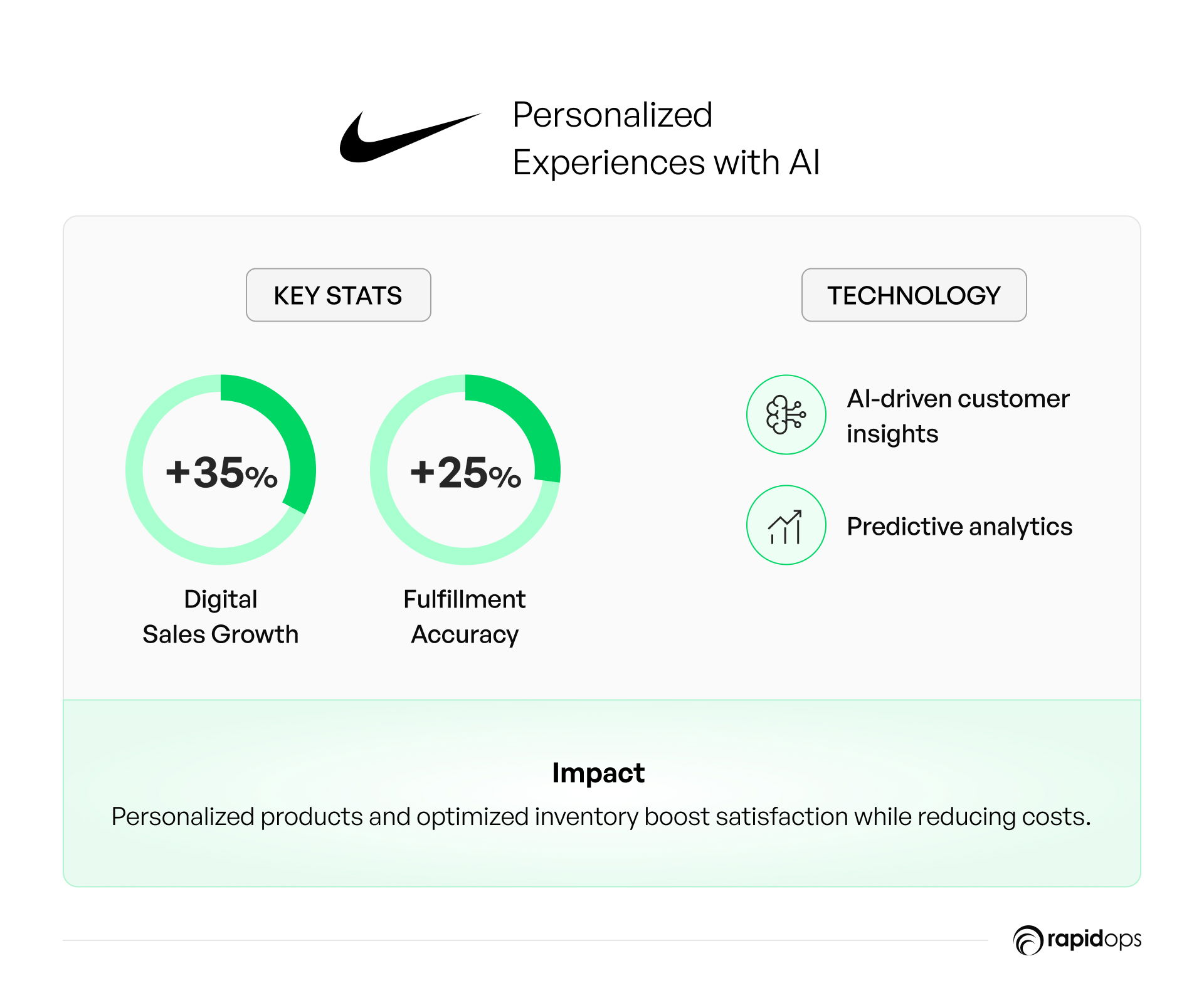
I. AI-Powered Personalization: Predicting What Customers Want
- What Nike Did: Nike shifted from basic recommendations to leveraging AI-driven insights that analyze vast datasets to predict individual customer preferences with precision.
- Result: This transformation led to hyper-personalized product suggestions delivered directly via its app, which boosted digital sales by 35% annually.
- Challenge: Nike had to overcome data segmentation challenges to ensure accurate insights were delivered globally, catering to diverse customer bases across regions.
Nike's personalized experience goes beyond traditional engagement, boosting loyalty and customer satisfaction, which directly drives revenue growth.
II. Smarter Operations: Revolutionizing Inventory Management
- What Nike Did: Nike used predictive analytics to overhaul its inventory management system. AI-powered demand forecasting could now predict purchasing behavior with remarkable accuracy, aligning stock levels to actual demand.
- Result: Nike saw a 25% improvement in fulfillment accuracy, a significant reduction in excess inventory, and faster delivery times to customers.
- Challenge: Integrating AI-based systems with existing legacy infrastructure across Nike's global operations required complex coordination, but the results far outweighed the effort.
This transformation helped Nike mitigate supply chain disruptions, boosting profitability and customer experience.
III. From Sportswear Brand to Digital Benchmark
- What Nike Did: Nike didn't just incorporate AI into one part of its business; it used AI, machine learning, and predictive analytics across its entire operations and customer engagement.
- Result: This holistic strategy has turned Nike into a digital benchmark for the retail industry, leading the charge in operational efficiency and customer engagement.
- Strategic Impact: With this transformation, Nike reinforced its competitive edge, setting new standards for the retail sector that others now follow.
Nike's digital pivot was not merely a tech upgrade but a complete reimagining of how they deliver value to customers, enhance operational efficiency, and maintain relevance in an increasingly tech-driven market.
II. Target: Real-Time Inventory Accuracy with IoT
Target faced inventory issues with outdated systems, leading to stockouts and lost sales. Implementing IoT technology revolutionized their approach, improving accuracy and elevating the customer experience.
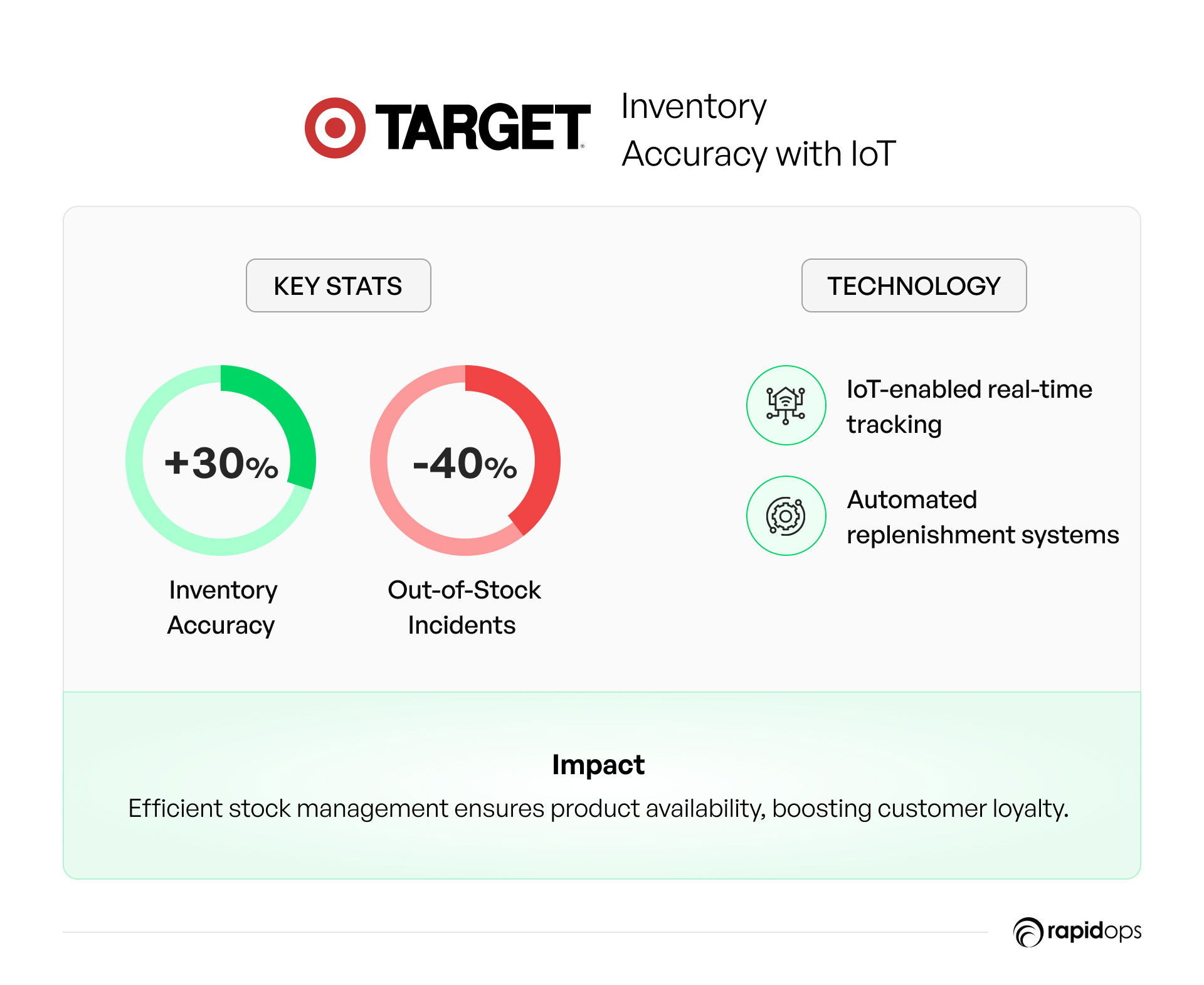
The Challenge
- Stockouts and Inventory Inaccuracy: Target struggled with inconsistent inventory tracking, leading to frequent stockouts and missed sales opportunities.
- Manual Systems: Traditional inventory management systems were time-consuming, inefficient, and prone to errors, affecting operational efficiency.
What They Did
- Adopted IoT Technology: Target implemented IoT-enabled devices across its stores to provide real-time updates on inventory.
- Automated Processes: By leveraging IoT, Target replaced manual inventory tracking, improving data accuracy and streamlining operations.
The Outcome
- 30% Improvement in Inventory Accuracy: Real-time tracking resulted in more precise inventory data.
- 40% Reduction in Stockouts: IoT-enabled devices ensured products were always available when needed.
Target's move to IoT not only streamlined operations but also solidified its position as an innovator in modern retail, enhancing customer satisfaction and reinforcing loyalty.
III. L’Oréal: Elevating Beauty Retail with AR and AI
L’Oréal has completely revolutionized its approach to beauty retail by embedding cutting-edge AR and AI technologies. This shift has dramatically changed how consumers interact with beauty products, setting a new standard in the industry.
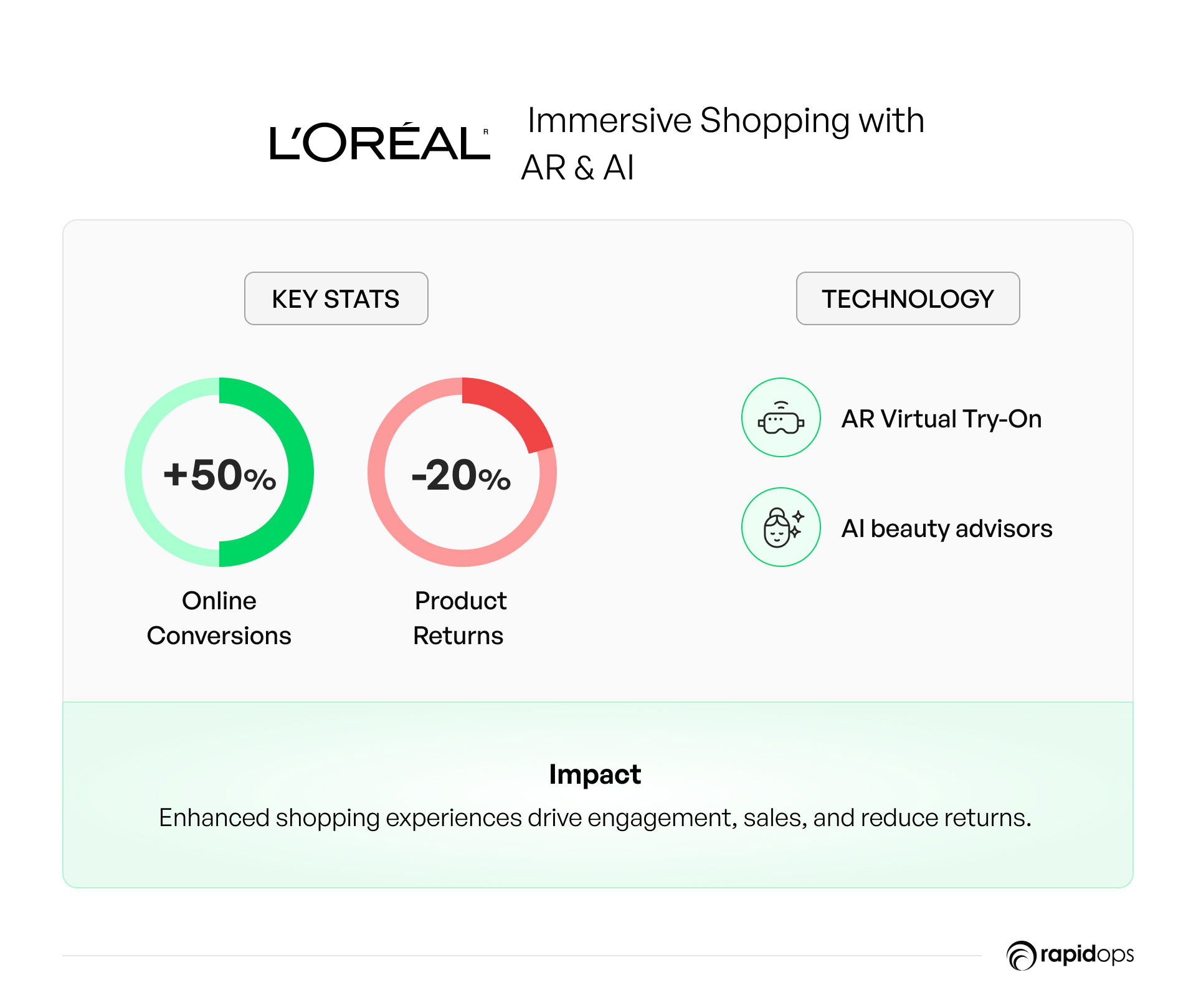
The Challenge
- Traditional Shopping Experience: Consumers struggled with making the right product choices without trying them first, leading to frustration and high return rates.
- Inaccurate Recommendations: Previous methods of suggesting products lacked personalization, which impacted customer satisfaction.
What They Did
- Virtual Try-On with AR: L’Oréal introduced an immersive Virtual Try-On tool, allowing customers to virtually try makeup shades and products from the comfort of their homes or in-store. This gave them the confidence to make more informed decisions.
- AI Beauty Advisor: The AI-powered beauty advisor makes personalized recommendations based on skin tone, preferences, and purchase history, offering a tailored experience for each customer.
The Outcome
- 50% Boost in Online Conversion Rates: The Virtual Try-On tool has driven a significant increase in conversions by offering a more engaging, interactive shopping experience.
- 20% Reduction in Product Returns: Customers are more confident in their purchases, reducing returns and improving overall satisfaction.
This transformation has propelled L’Oréal from traditional retail to a tech-driven model, enhancing both customer experience and business results.
Next Steps for Retailers: Embrace Digital Transformation
To achieve similar success, start by identifying your unique challenges. Whether it’s inventory management, customer engagement, or supply chain inefficiencies, the right digital tools can provide actionable solutions. Integrating these technologies strategically ensures smarter decisions, better operations, and long-term growth.
The Imperative for Action in Retail’s Digital Evolution
The retail landscape is undergoing a radical transformation. To remain competitive, it’s no longer enough to just keep up; your business must lead with vision, agility, and innovation. Digital transformation is the critical enabler of this journey, offering the solutions to not only enhance customer experiences but also optimize operations and drive sustainable growth. By leveraging technologies like AI, IoT, AR, and predictive analytics, businesses are turning today’s challenges into tomorrow’s success stories.
At Rapidops, digital transformation is more than just a service, it’s our expertise. With over a decade of experience partnering with retailers, we’ve helped businesses like yours streamline operations, integrate cutting-edge technologies, and drive tangible results. We don’t just deliver solutions; we collaborate with you to co-create strategies that align with your vision, empowering you to lead confidently in an evolving market.
If you're looking for an experienced digital transformation partner or are unsure where to begin, we invite you to book a strategy call with one of our experts. Let’s discuss how we can help you digitally transform your business and set the stage for long-term success. The future of retail starts now.
How has digital disruption transformed retail?
Digital disruption integrates technology into retail operations, enhancing customer experiences, streamlining processes, and fostering innovation. AI-driven personalization, IoT-enabled inventory management, and omnichannel strategies redefine how businesses operate, ensuring competitiveness in a dynamic market.
What are the 3 P's of digital transformation?
- People: Building skilled teams and customer-focused culture.
- Processes: Optimizing workflows and embracing automation.
- Platforms: Leveraging scalable technologies for agility.
What is 4.0 digital transformation?
Industry 4.0 applies IoT, AI, and data analytics to automate retail processes. It enables smarter supply chains, predictive insights, and immersive customer experiences, creating a connected and intelligent retail ecosystem.
What are the 3 pillars of a digital transformation plan?
- Technology: Selecting adaptable, scalable solutions.
- People: Driving change with adaptable teams.
- Strategy: Aligning tech initiatives with business goals.
What digital technology does retail need?
Retailers benefit from AI for personalization, IoT for real-time updates, AR/VR for immersive shopping, cloud computing for scalability, and blockchain for transparency, driving efficiency and customer satisfaction.
What will retail look like in 2025?
Retail will merge physical and digital experiences with AI, IoT, and AR/VR. Sustainability and blockchain will define supply chains, while personalization and convenience will dominate customer engagement.
What does digital transformation mean to your customers?
Digital transformation means delivering convenience, personalization, and trust to your customers. It’s about faster service, tailored experiences powered by data, and secure, reliable interactions. By meeting these expectations, you build loyalty, create value, and position your business as a leader in providing exceptional customer experiences.
How can digital transformation help my retail business grow?
Digital transformation drives retail growth by delivering personalized customer experiences, improving operational efficiency, and enabling data-driven decisions. It helps you adapt quickly to market trends, streamline processes, and build customer loyalty. Embracing technology future-proofs your business, deepens connections, and creates opportunities for sustainable growth in a competitive marketplace.

Rahul Chaudhary
Content Writer
With 5 years of experience in AI, software, and digital transformation, I’m passionate about making complex concepts easy to understand and apply. I create content that speaks to business leaders, offering practical, data-driven solutions that help you tackle real challenges and make informed decisions that drive growth.
What’s Inside
- How Digital Transformation is Reshaping Retail
- How Technology is Transforming the Retail Industry
- What Are the Biggest Challenges in Retail Digital Transformation?
- How Leading Retailers Are Using Digital Transformation to Drive Growth: Case Studies
- The Imperative for Action in Retail’s Digital Evolution

Let’s build the next big thing!
Share your ideas and vision with us to explore your digital opportunities
Similar Stories
- Transformation
- undefined Mins
- March 2022

- Transformation
- undefined Mins
- March 2020


Receive articles like this in your mailbox
Sign up to get weekly insights & inspiration in your inbox.
